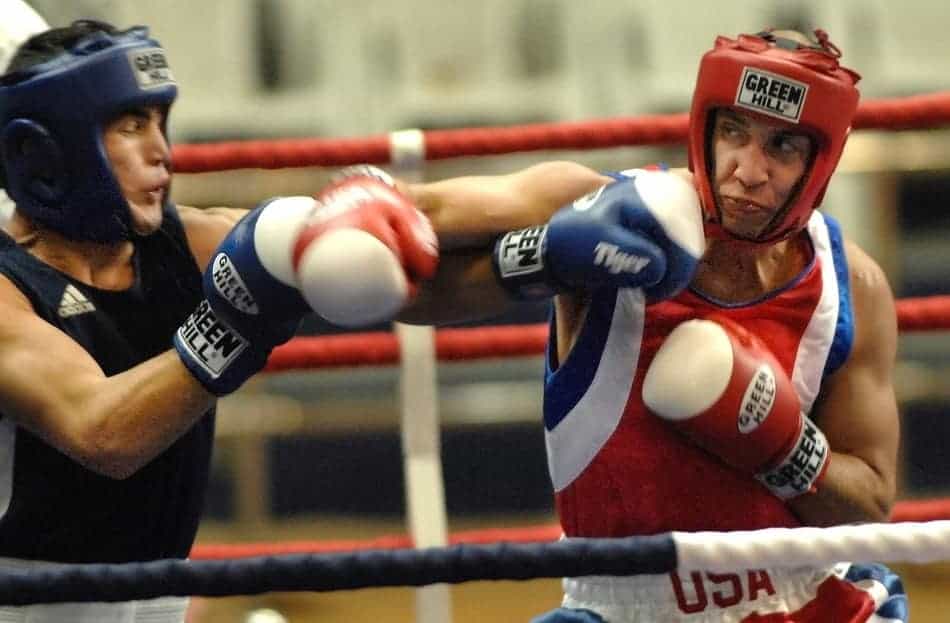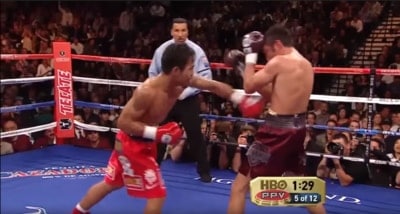
To box in your natural boxing stance is easy. But what about switching to a southpaw stance, even though you are right-handed? Is that going to benefit you or not? And if yes how?
Actually, there are some benefits. Which we are going to discuss in detail in this article. If you are a southpaw fighter, no matter if you are right or left handed, you need a specific strategy, different from the one orthodox fighters use.
After you read that article, make sure you check out also Southpaw Stance Strategy +21 Combination and Counters (opens in a new tab) where I talk about that strategy in detail.
But now, let’s dive into the 11 ways you can benefit from being a right-handed boxer, staying in a southpaw stance:
1. Stronger Jabs
The jab is the most commonly used punch in boxing. And that’s because it’s very effective. Using your jab, you can maintain the distance between you and your opponent, interrupt his attacks and set up bigger punches such as the cross or the overhand. Besides, maintaining a distance, you can also use it to close the distance (for example if you are shorter than the other boxer and want to fight from the inside).
The jab is also the fastest punch and usually, the boxers start their combinations with it. It’s so quick because your lead hand is closer to your rival than the rear hand, so the jab travels less distance than any other punch.
The downside of the jab
The problem with the jab is that it’s not the most powerful punch. You can’t knock someone out with just a jab. It’s a quick punch because it travels less distance, but because of this, it can’t build enough momentum so it’s not very powerful. Also when you are jabbing with your weak hand, that decreases the impact of the punch even more.
Powerful jab
But if you are a right-handed southpaw boxer, your power hand (the right hand) is also your lead hand. So you can jab with much more power, compared to a right-handed boxer, staying in an orthodox stance. You jabs will be also faster and more precise. Which can be really helpful to maintain the distance and to stop your opponent’s attacks.
You will also be able to throw powerful jabs, without risking your stance. And here is what I mean by that: If you throw a straight, it will take you much more time to get back in a stance, compared to when jabbing.
That’s because of the twist of your body when throwing a straight punch. But when jabbing, you can just throw the punch, without getting out of your stance. You just need to extend your arm, and not twisting your body so much, compared to when you throw a cross or a rear hook. Thus you will be more powerful with your lead hand, but also much faster and mobile during the boxing match (or sparring).
Combinations
One of the best (and also one of the simplest) boxing combinations is the 1-2 (jab-cross). It’s very quick, but also very powerful. If you are right-handed southpaw boxer, I recommend doing 1-2-1 (jab-cross-jab) instead of 1-2. This variation of 1-2 is better because usually, the last punch of the combination is the most powerful one. So to increase the impact of the combo, even more, it’s better to end it with your stronger hand. Also, using your jab, you will create enough space to exit the exchange. And lastly, your opponent may not expect it, because this is an unorthodox combination.
This is the punch numbering system used in boxing:
- Jab – 1
- Cross/straight – 2
- Lead hook – 3
- Rear hook – 4
- Lead uppercut – 5
- Rear uppercut – 6
Are you ready to get your boxing to the next level?
Watch a FREE Online Boxing Course by the boxing coach Brandon Ray!
You’ll learn:
1. How to fight bigger/taller opponents
2. How to close the distance without getting hit
3. Defense and Offense in the pocket
2. Stronger Lead Hooks
The lead hook is one of my favorite punches. I like it because it’s quick and you can use it in both situations – to counter your rivals and to attack them. It can be a very powerful punch, and usually, it’s hard to be seen. And that makes it one of the best knock out punches. Because the punches you don’t see, usually cause the knockout. So imagine staying in a southpaw stance and throwing a lead hook with your right hand – that can be really devastating… Similar to the jab, the southpaw lead hook will be much more powerful, fast and precise than the orthodox one. Thus you will have much more knock out potential.
A famous boxer whose main weapon was the lead hook was Joe Frazier. He knocked out many of his opponents using it. Thus he also dropped Muhammad Ali in their first fight.
Combinations
It’s very hard to catch someone with a “naked” lead hook. To land it, you need to set it up using combinations or to wait for the other boxer to attack and then counter him. A great combination for landing the lead hook is 1-2-3 (jab-cross-lead hook). It’s very cool because it’s harder for your opponent to see the hook after the jab and the cross. I also like it, because when you end a combo with your lead hand, that naturally brings you back in your stance. Because you shift your weight back to your back foot regaining your balance.
Another very effective combo is to fake a cross/overhand, to step in and to throw the lead hook. That’s not exactly a “combination” but it can be really dangerous, especially if your opponent reacts to the feint. Then he will expect a punch coming from your right and you can catch him off guard with your lead hook.
3. Stronger Lead Uppercuts
The lead uppercut can be a very effective punch in close distance or even in the clinch. But it can also be used for setting up combinations and to counter. Boxers like Myke Tyson and Anthony Joshua really mastered this punch. While Joshua uses it to counter his opponents when they come closer, Tyson used it in a variety of combinations. For example, one of his most impressive combinations was lead uppercut to the body followed by a lead uppercut to the head.
This punch is usually very short (travels short distance) so you can’t generate much power. But If you are in a southpaw stance (and you are right-handed), the power will be much different…
Combinations
When I am fighting against a taller opponent, one of my favorites combos is lead uppercut followed by a right cross to the head. It’s very effective against taller boxers because you can hop with the uppercut, which will help you to close the distance quicker. Also, the first punch (the uppercut) comes upwards and the second one comes straight, which makes the combination very hard to be blocked.
The second situation where you can use it is when you trapped someone against the ropes. In such situations what I like to do is to throw 2 hooks to the body (left and right) and then uppercut to the head. The idea here is to make your opponent protect his body and then land a clean punch to the head.
You can also use the lead uppercut to catch your someone when he tries to enter in a clinch or tries to walk you down. It’s a very quick punch and your rival won’t expect it to be so powerful (and it will be because you throw it with your power hand).
4. You are prepared for them, they aren’t
If you are a right-handed southpaw boxer, the statistic is on your side. Here is what I mean by that: 90% of the people are right-handed. That means that most of them are staying in an orthodox stance. The rest 10% are the southpaws. So, let’s say you are an orthodox boxer. When you go to the gym, chances are that you will spar with other orthodox boxers. And only in 10% of the times, you will train with southpaws (in a perfect scenario).
On the flip side, the southpaws train and spar with boxers like you all the time. So they know all of your tricks, but you aren’t prepared for them at all.
But if you use the southpaw stance, you can benefit from the lack of experience of the orthodox fighters against boxers like you and easily outbox them.
5. Outside lead foot advantage
When two boxers in opposite stances are fighting, their lead feet are facing each other. And this is important because:
The boxer who places his lead foot outside of the lead foot of his opponent has an advantage. Because when he does that, he is out of the center line. Thus making very hard for the other boxer to catch him. Actually, the only way for his rivals to land something is by throwing a lead hook or a jab, but this is also hard to be done.
On the other hand, the boxer whose lead foot is on the outside has the speed advantage. His rear hand is closer to his opponent, so he can throw a cross or a rear overhand and land them easily.
Here is a short video where you can see how Manny Pacquiao uses the outside lead foot advantage (look at the positioning of his right foot):
Tip: When you are trying to take the outside foot advantage, during a sparring, try to step with both of your feet (like Pacquiao does it in the video), don’t just step with your lead leg. Otherwise, you will just step in a wider stance which will make you lose your balance easily.
That was a mistake which I made when I spar with a southpaw for the first time. I thought that I just need to step with my lead foot outside of his lead foot to take the advantage. But that wasn’t the case. What you need to do is to position your whole body, at an angle where is hard for your opponent to land punches at you, but you can easily land punches on him.
*The lead foot advantage is available only when fighters with opposite stances are facing each other. So if you are a right-handed southpaw, you can use it against orthodox fighters (which are the majority of the boxers).
6. Trapping your opponent’s lead hand
Here is one more southpaw vs orthodox advantage you can take. You already know that your lead foot will face the orthodox fighter’s lead foot. But guess what, if you stay in a southpaw stance, your lead hand will also face his lead hand.
And you can take an advantage by trapping your opponent’s lead hand. That is really cool especially if you are shorter than the other boxer because you can eliminate the advantage of his longer reach. Because while trapping his lead hand, you will prevent him from throwing jabs at you. So he will be unable to keep you at distance with his nasty jabs.
But, regardless of that if you are tall or short, you can use this technique to land some punches. To do that, you just need to pull his lead hand and land straight left over the top. Here is how Vasyl Lomachenko does it.
The technique is very simple, the only thing you need to know is that you have to throw the straight left quickly, otherwise your opponent will catch you first.
7. Cool combinations
I already mentioned some really effective combos for right-handed southpaws such as the 1-2-1, or the 1-2-3. But there are many more!
For example, jab to the head followed by a left uppercut to the body is a REALLY nasty combination. That’s because your rear hand is your left hand. Which means that it will land on the RIGHT side of your opponent’s body – right on the liver. And the liver shots can be really devastating. You can literally TKO someone in a boxing match with a liver shot.
Yes, it won’t be the most powerful punch (because you will throw it with your left hand), but still, it can be really dangerous.
8. Advantages over other southpaws
The southpaw boxers have experience with the orthodox boxers and they have also experience with other southpaws. But what about right-handed southpaw – Hmm, I don’t think so. If you are a right-handed southpaw, you are probably the rarest type of boxer. Very few boxers have fought against someone like you. While you have sparred with both type of boxers – orthodox and southpaws.
Yes, a southpaw fighter will probably be prepared to fight against another southpaw. But they won’t be prepared for the power of the lead hand of a right-handed southpaw. Especially the power of the jab, because everyone expects the jab to be a less-powerful punch used to set up other(heavier) shots. So you will really surprise them.
9. Better control in the clinch
Here is something interesting: Unlike the most boxers, the wrestlers stand with their stronger foot (and hand) slightly in front of the other. Thus they are more explosive when they do takedowns. In boxing, you can’t take your opponent down, but you can use a similar strategy to take the upper hand in the clinches.
It can be really annoying fighting or sparring with someone who enters in a clinch all the time. But when your power hand is in front, you can control him easier or just push him back.
Lennox Lewis used a similar strategy to push Mike Tyson back when Tyson tried to come closer. Lennox just pushed him back and then landed some straight punches.
10. You can switch stances whenever you want
Switching stances is for more advanced boxers (or boxing enthusiasts). If you are a beginner and you are right-handed, you first need to learn how to box in an orthodox stance, before switching into a southpaw. Otherwise, you will start using your right hand too much and hardly use your left. Which isn’t good at all.
So, if you know how to fight in an orthodox stance, and then you decide to switch into a southpaw, we can say that you can box in both stances. And that can be really helpful in a boxing match (or in a sparring session).
Every time something goes wrong or you are in a bad situation or the southpaw stance just doesn’t work very well against your opponent, you can easily switch to your natural (orthodox) stance.
You can also switch stances to create better angles during the fight. Boxers such as Tyson Fury and Vasyl Lomachenko does that all the time.
11. It’s more fun
Sometimes a fight between two orthodox boxers can be really boring. That’s because they trained so many times with other orthodox boxers, that they probably developed an impenetrable defense.
It happened to me so many times when I spar with other orthodox boxers in the gym. Sometimes we are just jabbing each other and none of us can land bigger punches. Because we are blocking, slipping or parrying everything other than a fast, but the less powerful jabs.
In such cases, if you can switch stances, you can switch to southpaw and make it much more interesting. After all, the reason why we practice this sport is to have fun.
And the better you become at something, the more you enjoy it. That’s why I highly recommend trying new things such as switching to different boxing stances, so you can enjoy boxing and have fun even more.




Is it possible for a right handed person to be a natural southpaw? I used to get into a lot of fights and tried the orthodox stance and didn’t feel comfortable with it and i went back to the way i normally will fight. Witch is my right foot forward and my left foot in back. Is it strange that I’m right handed and when i fight i automatically put my right foot in front and my left foot in back?
Ok, so there are 3 reasons why you may feel more comfortable in a southpaw stance:
1. For some people, the southpaw stance is just more natural regardless they are right-handed
2. You may have a stronger right arm but also stronger left leg – that’s very rare but it’s possible. Or you may have a cross-dominance (you prefer to do some tasks with your left hand and others with your right hand).
3. You said that you get into a lot of fights. If you mean street fights, I noticed on all these YouTube videos of untrained people fighting on the streets, that most of them, fight with their power hand and foot forward. Looks like it’s more natural for people who don’t have experience in boxing or other standing combat sport. I don’t know if you have experience in such sports, that’s why I am assuming this also.
this is how I strike I am right handed but wrestle and bat with my left side, thought for a long time I was the only person like this. I uave trained Multiple types of striking, Boxing And BJJ and i can tell you this body type of cross dominance is actually super rare.
This makes so much sense. I thought it was weird how I won all my fights, even against well trained fighters. I never noticed how difficult it was to defend against southpaws. I didn’t even know how rare it was for right handed southpaws, my strong hand being right and actually being left handed mainly. This weird part of me brought me so many advantages I didn’t even notice until now. It’s nice to know so I can better understand and use these advantages more often.
My right hand is completely useless for tasks like writing, I am right handed and I stand southpaw. For me it’s the fact I can leading hook so hard because it’s my right arm, if my left arm is my lead my hooks aren’t as good. That’s the only reason I naturally stand like this! I’ve also had a lot of street fights so maybe this is something to do with the right hand forward too!
I am also right handed but it came naturally that my boxing stance is being a southpaw i feel more balance on it, my stronger part is on lead so i can easily maneuver my offense and defense using my strong side however what i noticed as my weaknesses are 1. My left hand is so innacurate in punching, less power and hard to control ,so awkward in throwing a punch from rear. 2. Its hard for me to step or move backwards it feels uncoordinated but when i go move or step forward it feels so balanced. 3. When i spar fighting an orthodox i always tend to place my lead foot inside and also move inside regardless when im in offense or defense very different from the rule you said that a southpaw should place is lead foot outside